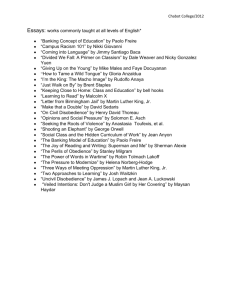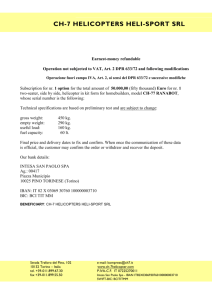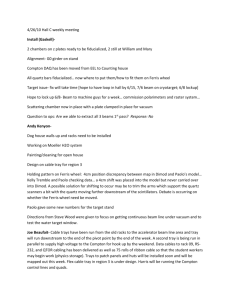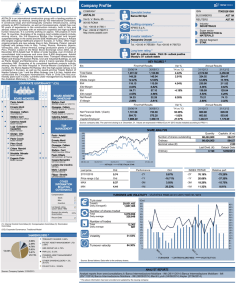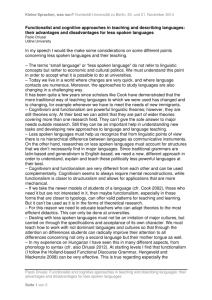CLD Second Grader - Oregon Department of Education
advertisement
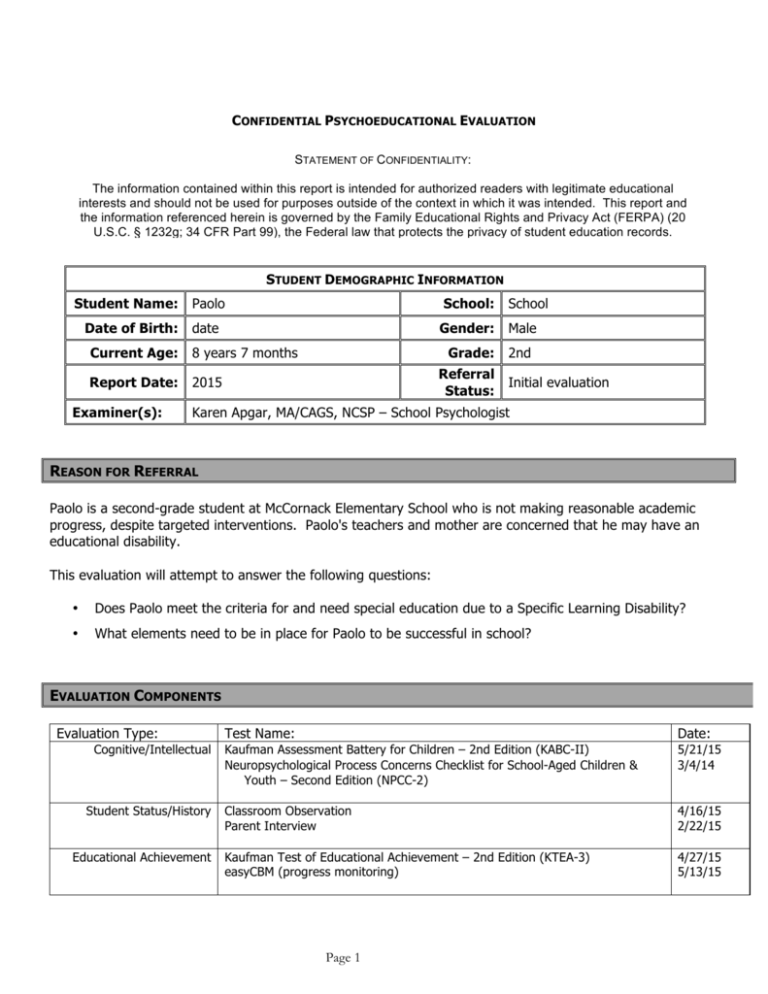
CONFIDENTIAL PSYCHOEDUCATIONAL EVALUATION STATEMENT OF CONFIDENTIALITY: The information contained within this report is intended for authorized readers with legitimate educational interests and should not be used for purposes outside of the context in which it was intended. This report and the information referenced herein is governed by the Family Educational Rights and Privacy Act (FERPA) (20 U.S.C. § 1232g; 34 CFR Part 99), the Federal law that protects the privacy of student education records. STUDENT DEMOGRAPHIC INFORMATION Student Name: Date of Birth: Paolo School: date Gender: Current Age: 8 years 7 months Report Date: 2015 Examiner(s): Grade: Referral Status: School Male 2nd Initial evaluation Karen Apgar, MA/CAGS, NCSP – School Psychologist REASON FOR REFERRAL Paolo is a second-grade student at McCornack Elementary School who is not making reasonable academic progress, despite targeted interventions. Paolo's teachers and mother are concerned that he may have an educational disability. This evaluation will attempt to answer the following questions: • Does Paolo meet the criteria for and need special education due to a Specific Learning Disability? • What elements need to be in place for Paolo to be successful in school? EVALUATION COMPONENTS Evaluation Type: Cognitive/Intellectual Student Status/History Educational Achievement Test Name: Date: Kaufman Assessment Battery for Children – 2nd Edition (KABC-II) Neuropsychological Process Concerns Checklist for School-Aged Children & Youth – Second Edition (NPCC-2) 5/21/15 3/4/14 Classroom Observation Parent Interview 4/16/15 2/22/15 Kaufman Test of Educational Achievement – 2nd Edition (KTEA-3) easyCBM (progress monitoring) 4/27/15 5/13/15 Page 1 Prior to evaluation, written authorization for assessment was obtained from Paolo’s parent, Sra Parent. Prior to assessment, all parental rights guaranteed by law were provided. BACKGROUND INFORMATION Developmental/Medical History: According to Sra. Parent, Paolo was born healthy after a typical pregnancy and delivery. He was a healthy baby and toddler, and there is no history of significant illness, injury or hospitalization. He did not even have any ear infections as a young child. Paolo lives with his parents and his three-year-old sister. His sister has a significant speech/language delay and is currently receiving speech therapy. According to Sra. Parent, Paolo has a good memory, can follow directions and appears to understand what he is told in both English and Spanish. He can stay very focused on preferred activities (especially Legos), and he enjoys social play with his cousin. Paolo demonstrates a good understanding and use of humore in both languages. There is no family history of learning challenges. Previous Assessments: Paolo has taken the English Language Proficiency Assessment (ELPA) for the past three years. In the spring of kindergarten, he earned a score as a Beginning speaker of English: In the spring of first grade, Paolo had advanced to an Early Intermediate speaker of English: Recently, in second grade, Paolo was again considered a Beginning speaker: Page 2 Of particular note is the fact that Paolo's speaking skills and listening skills advanced appropriately between kindergarten and first grade, but not from first to second grade: Speaking scores: 486 (K), 495 (1st), 495 (2nd) Listening scores: 471 (K), 498 (1st), 499 (2nd) July 2014: Paolo attended Summer School after first grade. His summer teacher reported tht Paolo was a stellar role model for other students, and he worked very hard. He had a difficult time recalling learned information and skills from day to day. Over the four weeks of Summer School, Paolo progressed from knowing 18 letter sounds to knowing 39 letter sounds. January 2015: The district's bilingual Speech-Language Pathologist spent time conversing with and informally screening Paolo's language. She concluded that Paolo is very effective a code-switching between languages, which indicates that he is developing well in both English and Spanish. He does demonstrate some language errors, yet they are typical for an emerging bilingual. He was able to use his language well and demonstrated a very witty sense of humor. Overall, the bilingual Speech-Language Pathologist does not have concerns about Paolo's language processing. Instructional History: Paolo did not begin learning English until kindergarten. He has now been receiving English Language Development support for three years. Discipline History: None noted. Consideration of cultural background, English proficiency, environmental & economic factors: Paolo is a Latino boy being raised in a Spanish-speaking household that is influenced by both mainstream U.S. and traditional Mexican culture. Based on a interview with his mother, there do not appear to be any environmental or economic factors that could be considered the primary reason for Paolo's academic challenges. However, issues of language and culture may be considered primary factors in his learning rate and level, and these should be considered when making educational decisions for Paolo. INSTRUCTIONAL INTERVENTIONS Paolo attended summer school after kindergarten and after first grade. The program focused on reading, using Read Well and interventions from the Triumphs program. This year, in addition to regular classroom instruction, Paolo has worked on phonics instruction and practice in the first grade ELD group and the 2nd grade ELD group each day, for 30 minutes each time. He also receives targeted instruction in word-reading using the Reading Mastery curriculum for 30 minutes per day. ASSESSMENT OF ACADEMIC SKILLS: The Kaufman Test of Educational Achievement, Second Edition (KTEA-3) is an individually administered battery of assessments of the key academic skills in reading, math, written language, and oral language. The comprehensive form is designed for use with children and young adults from ages 4-years, 6months to age 25. A score between 85 and 115 is considered average. A visual representation of Paolo’s performance is provided below. Scores to the left of the vertical line indicate below-average performance: Page 3 Observations during testing: Paolo was a cooperative, cheerful and happy student who was willing to try all activities during testing. He appeared to try very hard to do his best, but did not seem to recognize when he was answering items correctly or incorrectly. Paolo often looked to the examiner to confirm or approve of his answers. Page 4 READING: Progress Monitoring data (easyCBM): Paolo's reading fluency is currently being monitored for progress using the First Grade easyCBM measures. He has demonstrated approximately 85% accuracy in word reading, and is currently able to read 35 correct words per minutes at the first grade level. This falls at the 30th percentile. First grade reading fluency Teacher report/Classroom-based assessments: According to Paolo's second grade teacher, Ms. Wagoner, Paolo relies heavily on memorized words, rather than sounding-out new ones. He can lose his place when reading with the class, and he has a hard time understanding what he has read. Paolo sometimes picks up on small details, but usually misses the big picture of the story. He does not avoid reading and always has a positive attitude toward reading activities. In mid-second grade, Paolo demonstrated incomplete Phonemic Awareness – he succeeded at rhyming, oral sound blending and initial sound identification, but was not able to segment or manipulate phonemes. He scored 30% accuracy on a decoding assessment, being most accurate with beginning and ending sounds, but struggling with the middle of the word. Individual assessment (KTEA-3): Overall, Paolo demonstrated very low reading skills. He had a hard time identifying individual sounds in words, and rhyming and segmenting words was difficult for him. He did not use a consistent, reliable method to figure out unknown words. He usually guessed words based on the first letter. He did not appear to recognize if the word he had guessed was a real word or not. His poor reading accuracy impacted his fluency and comprehension, and he rarely understood what he had read. Paolo did recognize many words by sight, rather than trying to sound them out. MATHEMATICS: Benchmark data (easyCBM): Paolo's overall math skills were measured using the second grade easyCBM measure. As shown below, his math skills currently fall below the 10th percentile. Page 5 2nd grade CCSS math Teacher report/Classroom-based assessments: According to Ms. Wagoner, Paolo has a hard time with basic math concepts. Even with simple calculations, modeling and direct assistance, math seems very confusing for him. Classroom observations: Paolo was observed working on math calculations using the laptop computer. When given the problem 7 – 2, he did not know how to respond. Using a 100s chart, he arrived at the answer 11. He spent a lot of time looking around the room until an adult came near; then he looked at his math work. He appeared to be mostly guessing at answers. After an adult reminded him how to use the 100s chart to count backwards, he was able to answer the next several subtraction problems. He had been using the chart incorrectly. Individual assessment (KTEA-3): Math was Paolo's lowest skill area. He had difficulty with place value, symbols (+ and – and =) and was not able to complete calculation problems unless there were visuals for him to count. He demonstrated good touch-and-count skills, but did not demonstrate automatic recognition of numbers or numerals. When asked what grade he was in, he guessed 4th, then stated his room number, 14. WRITTEN EXPRESSION: Teacher report/Classroom-based assessments: According to Ms. Wagoner, Paolo's handwriting is difficult to decipher. In addition, he struggles to spell, even phonetically, so it is difficult to read what he has written. When possible, others scribe for Paolo. A review of Paolo's writing journal from class shows that his control of letter formation, word spacing and organization has not improved much across the school year. Paolo appears to stick with simple sentences, repeating the same sentence structure each time. Most of his free-choice writing is about the videogame Minecraft. When he works slowly and concentrates, it appears that Paolo can create much more legible writibing. His spelling is somewhat phonetic, though he tends to leave out vowels, which makes it difficult to determine what he has written. Page 6 Individual assessment (KTEA-3): Paolo's writing skills are very low. He is able to spell several words that he wanted to write, and he wrote somewhat fluently. However, he was not able to spell more than basic CVC (consonant-vowel-consonant) words. Sound-symbol correspondence was not automatic for him. It is difficulty to read due to the lack of phonetic spelling. He seemed to have strong ideas about what to write, but had difficulty with grammar and punctuation. He was able to put his ideas into a logical sequence, but used very short, simple sentences. Paolo does not yet know how to write his last name. ASSESSMENT OF BASIC PSYCHOLOGICAL PROCESSES: Kaufman Assessment Battery for Children, 2nd Edition (KABC-II) The KABC-II is an individually-administered, norm-referenced assessment of intelligence for individuals between the ages of five and eighteen. It is comprised of four components that measure different areas of cognitive processing: planning, attention, simultaneous and successive. The four processing areas comprise a complex and interdependent system of cognitive ability. The assessment yields scores for each of the processing areas (mean = 100, SD = 15). The assessment yields scores for each of the processing areas (mean = 100, SD = 15). Paolo's performance is represented, visually, below. The scores on the measures of cognitive ability may be influenced by a variety of factors including the individual’s ability to concentrate, previous exposure to various educational and social experiences, or physical impairments relating to vision, hearing, speech and coordination. Low scores may reflect intellectual impairment, but other factors such as anxiety, depression, and physical or emotional trauma have been shown to cause cognitive, academic, and social delays. Page 7 Consideration of Linguistic and Cultural Factors on the KABC-II Despite attempts by researchers and publishers to significantly reduce the amount of linguistic demand and cultural loading in intellectual assessments, these influences can never be completely eliminated. The Cultural Linguistic Interpretive Matrix (C-LIM) has been designed to determine how much a student's language and culture may be influencing her performance on the KABC-II. In the following graph, the shaded area with a dotted line represents that expected Average score area for a non-fluent English speaker and/or a child not raised in the dominant White culture of the United States. When a student's scores fall within that range, it suggests that the resulting pattern of strengths and weaknesses on the KABC-II are largely due to that student's culture and language differences. However, when students score in a pattern that is atypical of that range, it suggests that the resulting pattern of strengths and weaknesses on the KABC-II are likely due to actual differences in the student's abilities. The following graph shows the five score areas for Paolo. Given that he scored highest on tasks with high levels of cultural/linguistic demand, and scored lowest on tasks with low cultural/linguistic demand, it appears that the strengths and weaknesses on Paolo's KABC-II are likely true representations of Paolo's actual psychological processing strengths and weaknesses, rather than an artifact of any linguistic and cultural differences. MEMORY: The Memory Process is a complex and multifaceted domain related to many areas of learning. Specific kinds of memory are used depending on task demands. The memory process involves the ability to store and retrieve information in a useful manner. Measures of this process include short term memory, working memory, associative memory and long term retrieval. On the Neuropsychological Processing Concerns Checklist (NPCC-2), Ms. Wagoner reported that it is very hard for Paolo to follow verbal directions, even when they are presented in Spanish. He frequently loses items, has a hard time finding things when asked and continues to seem surprised when asked to go to his English Language Development class, even though it is part of his daily routine. Similarly, even though the students have been using the classroom computers each week this year, Paolo still does not know the steps to log-on to the system. Paolo also does not appear to recognize that his two ELD classes are working on the same material and that he is repeating the same tasks from eariler in the day. Page 8 He seems to have a hard time following multi-step instructions and often loses his train of thought, even when in a one-on-one situation. Paolo's Short Term Memory was assessed using the Sequential section of the KABC-II. This process refers to an individual’s ability to keep things in a particular order and is often considered a measure of Short-Term Memory. Sequential processing is essential when learning new skills and tasks. To perform well in this area of the assessment, students need to remember the order verbal and/or visual information, and comprehend that each piece of information is related to the preceding one in order to solve the problem. Paolo’s sequential processing abilities fell in the very low range. Paolo's Long Term Memory was assessed using the Learning section of the KABC-II. This is a psychological process that involves attention, concentration, and memory. To do well in this assessment, students need to pay attention to new information and retain that information for use at a later time. This can also be described as Long-Term Memory (storage and retrieval), and is necessary in all aspects of the educational environment. Paolo demonstrated learning abilities in the below average range. ATTENTION: The Attention Process involves the individual’s ability to attend to, or to selectively attend to, perceptual information in a systematic and effective manner. This process includes measures of selective attention, sustained attention, response inhibition, attention shifting, and focus. On the Neuropsychological Processing Concerns Checklist (NPCC-2), Ms. Wagoner reported that Paolo is able to maintain focus if he is engaged in the activity. In larger instructional groups, though, he loses his focus. He freqently loses his place in academic work and does not know what to do next. LANGUAGE USE: The Language Use Process involves the individual’s skill at using verbal information to define concepts and solve problems. Language Use includes both the understanding and production of meaningful speech and communication. Language Use may include measures of receptive language, expressive language, listening comprehension, vocabulary development, and general knowledge. On the Neuropsychological Processing Concerns Checklist (NPCC-2), Ms. Wagoner reported that Paolo has a limited vocabulary, so he has a hard time expressing himself. He often cues off peers to determine what to do next, as he often does not understand the instructions. This is true in English and in Spanish. Paolo's Language Use was assessed with the Knowledge index of the KABC-II. This index is dependent on a student’s acquired knowledge, understanding of vocabulary terms and ability to apply verbal reasoning. Items on this scale typically require oral responses to verbally presented questions. Paolo’s performance placed him in the low range. PROCESSING SPEED: Processing Speed can be globally defined as the ability to make efficient and rapid decisions or quickly perceive distinctions in stimuli. Processing involves input and output mechanisms, and is frequently demonstrated under timed conditions. Measures of processing include processing speed, automaticity, and rapid decision-making. Processing may also include aspects of Rapid Automatic Naming facility, though this is an overlapping domain with memory. Page 9 On the Neuropsychological Processing Concerns Checklist (NPCC-2), Ms. Wagoner reported that Paolo responds quite slowly when asked questions, and he needs a lot of extra time to complete tasks in class. Paolo’s Processing Speed was estimated by looking at the Oral Fluency portion of the KTEA-3. Associational Fluency and Rapid Automatic Naming indicate the speed at which students can access verbal information from long-term memory; it is also referred to a Speed of Lexical Access. This can relate to a student’s ability to quickly generate ideas or to recall information associated with a certain object or concept. Paolo performed in the low-average in this area. MENTAL CONTROL: The Mental Control Process may be thought of as an individual’s ability to manage and prioritize perceptions to facilitate decision-making and Analysis/Reasoning. Mental control allows the individual to recognize the nature of a problem, plan a course of action, and sequence multiple actions to solve a problem. Mental Control abilities may be identified through measures of executive functioning, planning, organization, and self-regulation. On the Neuropsychological Processing Concerns Checklist (NPCC-2), Ms. Wagoner reported that Paolo seems to have a hard time getting started on activities. However, once he starts, he rarely gives up. He often makes the same mistakes over and over, even after they have been corrected. He often seems confused when new activities occur. Paolo's Mental Control was assessed with the Planning section of the KABC-II. Planning is a psychological process that involves high-level decision-making and utilizes analysis, planning and organziation. Planning is important to any situation in which a problem or task needs to evaluated and solved in an efficient manner. To do well in this assessment area, students need to engage in good strategies, control of behavior, selfmonitoring, and self-correction. Paolo demonstrated planning abilities in the low-average range. ANALYSIS/REASONING The Analysis/Reasoning Process is a complex activity that involves multiple processes. The Analysis/Reasoning Process is defined by an individual’s skill at analysis and synthesis of multiple elements to resolve problems. Measures of Analysis/Reasoning and judgment include reasoning skills, decision-making, and fluid reasoning. Paolo's Analysis/Reasoning was assessed using the Simultaneous section of the KABC-II. This process refers to an individual’s ability to relate and integrate pieces of information, such that the relationship between the pieces must be incorporated into a complete pattern or idea. Simultaneous processing requires information (usually visual) to be understood simultaneously in order to solve a problem. To do well in this area on the test, students need to relate parts into a group or whole, understand relationships among pictures and objects, and work with spatial relationships. Paolo’s simultaneous processing abilities fell in the very low range. AUDITORY: The Auditory Process is not intended to be a measure of the sensory mechanism of hearing. Rather, it is intended to be the underlying cognitive mechanism involved in using auditory information for the purpose of learning. Measures of the auditory process may include phonemic awareness (including Page 10 rhyming, segmentation, sound-symbol association, etc.), auditory perception, sound discrimination, and auditory mental manipulation. On the Neuropsychological Processing Concerns Checklist (NPCC-2), Ms. Wagoner reported that Paolo has difficulty with consistently using the correct letter sounds, blending consonant sounds and basic rhyming skills. Paolo's Phonological Awareness was assessed using the Phonological Processing portion of the KTEA-3. This process refers to an individual's ability to recognize that words are made up of discrete sounds and identify the individual sounds that make up words. Phonological awareness requires the student to rhyme, match, blend, segment and selectively delete individual sounds from words. Paolo's phonological awareness fell in the significantly low range. VISUAL: The Visual Process is defined by cognitive mechanisms that are involved in the retention, processing, and organization of visual information so as to demonstrate accurate perception. These should not be confused as a measure of the sensory mechanism of sight, but rather as indicators of the more complex underlying cognitive activities. Measures of the visual process may include factors such as spatial awareness, visual perceptual skills, perceptual organization, visual mental manipulation, and perceptual discrimination. On the Neuropsychological Processing Concerns Checklist (NPCC-2), Ms. Wagoner reported that Paolo sometimes struggles to work with visual-spatial activities, though he performs much better if there is a visual model for him to follow. SENSORIMOTOR: The Sensori-Motor Process involves integration of perceptual and cognitive skills to organize physical output. The Sensory-Motor Process can include all types of motor output including speech, gross motor, and fine motor skills. For the use as a basic psychological process involved in learning, Sensori-Motor primarily involves fine motor output. The Sensori-Motor Process may include measures of visual-motor integration, motor speed, and overall fine/gross motor skills. On the Neuropsychological Processing Concerns Checklist (NPCC-2), Ms. Wagoner reported that Paolo does not appear to have any significant motor challenges. ANALYSIS OF RESULTS: "Specific Learning Disability" means a disorder in one or more of the basic psychological processes involved in understanding or in using language, spoken or written, which may manifest itself in an imperfect ability to listen, think, speak, read, write, spell or do mathematical calculations. Specific learning disability includes conditions such as perceptual disabilities, brain injury, dyslexia, minimal brain dysfunction, and developmental aphasia. The term does not include learning problems that are primarily the result of visual, hearing, or motor disabilities, intellectual disability, emotional disturbance, or environmental, cultural, or economic disadvantage. [Oregon Administrative Rule 581015-2000 (4)(i)]. Page 11 Students who qualify for Special Education services under the category of Specific Learning Disability do not achieve adequately for their age or to meet Oregon grade-level standards. • Based on easyCBM, Paolo does not yet meet state standards in reading or math. Students who qualify under Specific Learning Disability may also exhibit a pattern of strengths and weaknesses in performance, achievement, or both, relative to age, Oregon grade-level standards, or intellectual development, that is determined to be relevant to the identification of a specific learning disability. • Processes: Paolo demonstrates strong Processing Speed, Mental Control and Long-Term Memory; conversely, his Auditory (phonological), Short-Term Memory and Analysis/Reasoning processing areas are quite weak. • Academics: At grade level, Paolo does not demonstrate clear strengths. However, his progress at the first-grade level, in reading, indicates that he is capable of learning how to read when given adequate time and targeted instruction. Visual representation of Paolo's processes: Although scores below 80 are generally considered to be significantly low and scores at or above 90 are considered to be average, research has shown that scores on these types of standardized tests are consistently lower for children with cultural/linguistically diverse backgrounds. Therefore, in Paolo's case, 70 should be considered significantly low and 80 and above should be considered average: RECOMMENDATIONS: Based on current evaluation, and considering Paolo's emerging bilingual status and non-mainstream cultural background, it appears that Paolo does demonstrate clear strengths and weaknesses that suggest a Specific Learning Disability. While the academic strengths are not as clear, there is some supporting evidence that reading is stronger than math. Also, deficits in short-term memory can impact multiple areas of academics. The final determination of eligibility and need for special education services will be made by Paolo's team. Page 12 Recommendations to consider: • Paolo may benefit from explicit instruction in math facts, math procedures and number concepts. • Using an instructional model that utilizes memorization of sight words or whole word recognition in addition to decoding strategies might be most effective with Paolo. • Continued English Language Development services will be necessary, as well as vocabulary-building opportunities through all of his instructional settings. • Breaking tasks into their component parts, along with visual cues to follow the steps in a procedure, may be helpful. Please feel free to contact me with any questions or concerns about this evaluation. Respectfully submitted, Karen Apgar, MA/CAGS, NCSP School Psychologist Eugene School District 4J 541-790-7820 Page 13 RESULTS OF STANDARDIZED ASSESSMENTS: The Kaufman Test of Educational Achievement, Second Edition (KTEA-3) Page 14 Kaufman Assessment Battery for Children, 2nd Edition (KABC-II) Page 15


